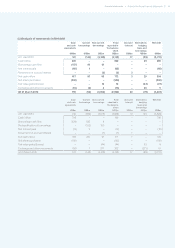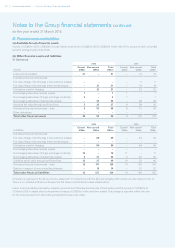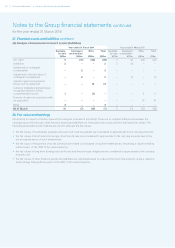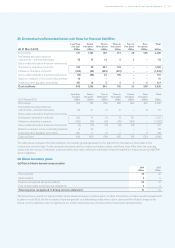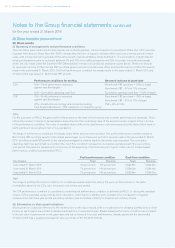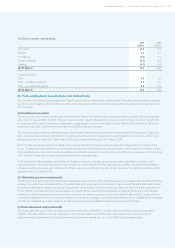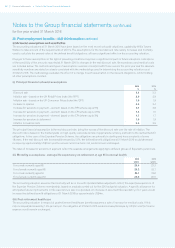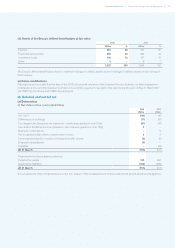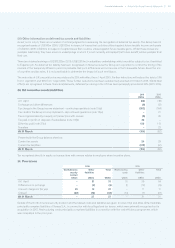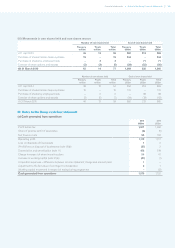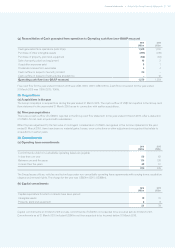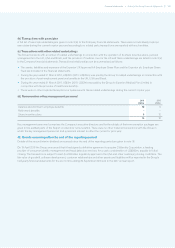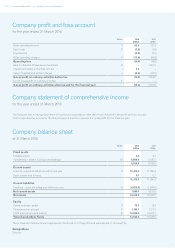Experian 2016 Annual Report Download - page 162
Download and view the complete annual report
Please find page 162 of the 2016 Experian annual report below. You can navigate through the pages in the report by either clicking on the pages listed below, or by using the keyword search tool below to find specific information within the annual report.
160
Notes to the Group financial statements continued
for the year ended 31 March 2016
Financial statements •Notes to the Group nancial statements
32. Post-employment benefits – IAS 19 information continued
(c) Actuarial assumptions and sensitivities
The accounting valuations at 31 March 2016 have been based on the most recent actuarial valuations, updated by Willis Towers
Watson to take account of the requirements of IAS 19. The assumptions for the real discount rate, salary increases and mortality,
used to calculate the present value of the defined benefit obligations, all have a significant effect on the accounting valuation.
Changes to these assumptions in the light of prevailing conditions may have a significant impact on future valuations. Indications
of the sensitivity of the amounts reported at 31 March 2016 to changes in the real discount rate, life expectancy and medical costs
are included below. The methods and types of assumptions used are consistent with those used in the prior year and the absolute
sensitivity numbers are stated on a basis consistent with the methodology used in determining the accounting valuation as at
31 March 2016. The methodology evaluates the effect of a change in each assumption on the relevant obligations, whilst holding
all other assumptions constant.
(i) Principal financial actuarial assumptions
2016
%
2015
%
Discount rate 3.4 3.3
Inflation rate – based on the UK Retail Prices Index (the ‘RPI’) 2.9 2.9
Inflation rate – based on the UK Consumer Prices Index (the ‘CPI’) 1.9 1.9
Increase in salaries 3.4 3.4
Increase for pensions in payment – element based on the RPI (where cap is 5%) 2.7 2.8
Increase for pensions in payment – element based on the CPI (where cap is 2.5%) 1.5 1.5
Increase for pensions in payment – element based on the CPI (where cap is 3%) 1.7 1.7
Increase for pensions in deferment 1.9 1.9
Inflation in medical costs 5.9 5.9
The principal financial assumption is the real discount rate, being the excess of the discount rate over the rate of inflation. The
discount rate is based on the market yields on high-quality corporate bonds of appropriate currency and term to the defined benefit
obligations. In the case of the Experian Pension Scheme, the obligations are primarily in sterling and have a maturity of some
18 years. If the real discount rate increased/decreased by 0.1%, the defined benefit obligations at 31 March 2016 would decrease/
increase by approximately US$19m and the annual current service cost would remain unchanged.
The rates of increase for pensions in payment reflect the separate arrangements applying to different groups of Experian’s pensioners.
(ii) Mortality assumptions - average life expectancy on retirement at age 65 in normal health
2016
years
2015
years
For a male currently aged 65 23.4 23.3
For a female currently aged 65 25.2 25.1
For a male currently aged 50 24.7 24.6
For a female currently aged 50 26.6 26.5
The accounting valuation assumes that mortality will be in line with standard tables adjusted to reflect the expected experience of
the Experian Pension Scheme membership, based on analysis carried out for the 2013 actuarial valuation. A specific allowance for
anticipated future improvements in life expectancy is also incorporated. An increase in assumed life expectancy of 0.1 years would
increase the defined benefit obligations at 31 March 2016 by approximately US$4m.
(iii) Post-retirement healthcare
The accounting valuation in respect of post-retirement healthcare benefits assumes a rate of increase for medical costs. If this
rate increased/decreased by 1.0% per annum, the obligation at 31 March 2016 would increase/decrease by US$1m and the finance
expense would remain unchanged.



